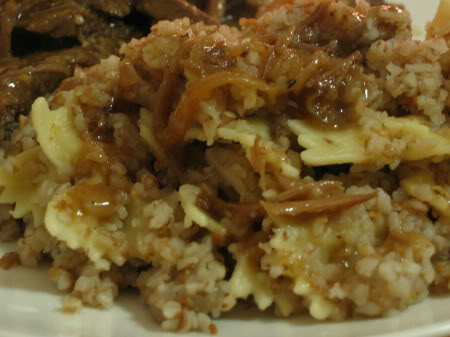
“But when from a long-distant past nothing subsists, after the people are dead, after the things are broken and scattered, taste and smell alone, more fragile but more enduring, more unsubstantial, more persistent, more faithful, remain poised a long time, like souls, remembering, waiting, hoping, amid the ruins of all the rest; and bear unflinchingly, in the tiny and almost impalpable drop of their essence, the vast structure of recollection.” –Marcel Proust, Swann’s Way
Food and memory are inextricably linked. But what happens when the flavor of a beloved dish from childhood is altered slightly, just enough to make everything feel off? In my experience, the results can range from mild disappointment to enervating distemper. The other night, to go along with some leftover brisket from my family Hanukkah party, I made kasha varnishkes. I tweaked my mom’s recipe a bit. It was a terrible, horrible mistake.
Kasha varnishkes is one of my all-time favorite foods. The nutty, puffy grains, the sweetly caramelized onions, the toothy bowties…sigh. During a year or two when I thought I was a vegetarian, I often cooked it for dinner—graduating it from a stellar side dish to the headlining attraction, making it the Paul Giamatti of my cooking repertoire. In our family recipe (which is, of course, adapted from the back of the Wolff’s kasha box), the liquid used is always plain old, good old water, and the mushrooms are canned. Driven by foodie snobbery, I suppose, I got it into my head that swapping in a little chicken broth could only be a good thing—it would deepen the flavor and make it more substantial. My mom and I have actually discussed this before, and she has always insisted that the only proper way to make kasha varnishkes is with water. Damn if she wasn’t right.
It’s funny—I knew enough not to tamper with the mushrooms, and used a jar of Green Giant. But when it came to the main flavor base, the ingredient that would infuse each grain of kasha with its uniquely fluffy, firm bite…well, there I thought I could get all fancy and make something better than my own mother. It was a small substitution—just one cup of chicken broth in place of half the water, but it was nearly enough to ruin the dish. I still ate it, of course—even with broth it was yummy—but it wasn’t the memory-heavy perfection I anticipated.
The other place I went wrong was in the preparation itself. My mom cooks the kasha first, then lets it sit in the pot while she cooks the noodles. This has always struck me as a bit backwards—it seemed much more streamlined to prepare the noodles and hold them over a pot of simmering water until the kasha was ready. So that’s what I did. Turns out there’s a reason for most things, even in old-fashioned recipes. The kasha actually needs those fifteen or twenty minutes to sit, untouched, and absorb whatever moisture remains in the pot. It is that little chunk of time, in fact, that makes the dish. Eaten right away, the kasha is mushy and slightly mealy and wholly unsatisfying. But the reward for patience is great, as I discovered when I went to put away the leftovers. What had been an altogether incorrect rendition of kasha varnishkes had, with time to just sit, transformed into a textbook example. The texture of the leftovers, which I had for breakfast the next day, was pretty near fabulous. But that taste, oh that taste. It was still off, just a little bit.
I was wrong. Ma, I apologize.
Kasha Varnishkes
Serves 4 as a side, 2 as a vegetarian main course
A good glug of vegetable oil
1 large onion, coarsely chopped
1 small jar sliced mushrooms
1 cup medium buckwheat groats (kasha)
1 egg white, lightly beaten
2 cups boiling water
1 cup uncooked bowtie egg noodles [growing up it was always Goodman’s brand, but I substituted farfalle and it was ok]
Generous salt & pepper, to taste
Heat the oil in a medium-sized saucepan and sauté the onions until golden brown. Add the mushrooms and sauté another minute, then remove mixture from pan and reserve. Wipe the pan with paper towels to remove excess oil. [You could also do this step in a skillet, but I hate dirtying an additional pan.]
In a small bowl mix kasha with egg until each grain is well coated. Place in the saucepan over moderately high heat, and stir constantly until grains separate and begin to dry. Return onions and mushrooms to the pan and stir. Remove from heat and quickly pour boiling water over kasha. [Be careful—there will be considerable sputtering when the hot water hits the dry pan!] Add salt and pepper and stir. Cover tightly and cook over very low heat for 10 to 15 minutes, or until all the liquid is absorbed. Remove from heat and set aside.
Bring a pot of salted water to a boil and cook the bowties according to package directions, until tender. Drain and stir into the kasha-vegetable mixture.
Served as a side dish with brisket or pot roast gravy on top, it’s absolute heaven. As a vegetarian main course, it’s still pretty damn good.